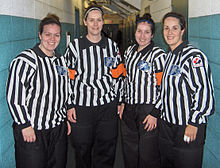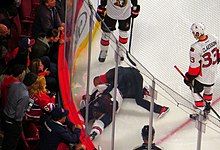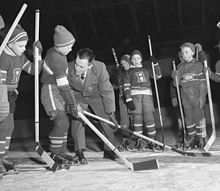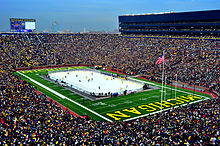Ice hockey
Ice hockey is believed to have evolved from simple stick and ball games played in the 18th and 19th centuries in Britain, Ireland, and elsewhere, primarily bandy, hurling, and shinty.
Players are prohibited from kicking the puck into the opponent's goal, though unintentional redirections off their body or equipment, including skates, are permitted.
Up until the 1999–2000 season, regular-season NHL games were settled with a single five-minute sudden death period with five players (plus a goalie) per side, with both teams awarded one point in the standings in the event of a tie.
From the 1999–2000 until the 2003–04 seasons, the National Hockey League decided ties by playing a single five-minute sudden-death overtime period with each team having four skaters per side (plus the goalie).
[12] International play and several North American professional leagues, including the NHL (in the regular season), now use an overtime period identical to that from 1999–2000 to 2003–04 followed by a penalty shootout.
If the score remains tied after an extra overtime period, the subsequent shootout consists of three players from each team taking penalty shots.
The governing body for United States' amateur hockey has implemented many new rules to reduce the number of stick-on-body occurrences, as well as other detrimental and illegal facets of the game ("zero tolerance").
The system is used in every NHL game since 2001, at IIHF World Championships, the Olympics and in many professional and high-level amateur leagues in North America and Europe.
Goaltenders wear specialized goalie skates (these skates are built more for movement side to side rather than forwards and backwards), a jock or jill, large leg pads (there are size restrictions in certain leagues), blocking glove, catching glove, a chest protector, a goalie mask, and a large jersey.
Each player other than the goaltender carries a stick consisting of a long, relatively wide, and slightly curved flat blade, attached to a shaft.
[23] Some teams in the Swiss National League are testing out systems that combine helmet-integrated sensors and analysis software to reveal a player's ongoing brain injury risk during a game.
[24] Furthermore, if the app determines that a particular impact has the potential to cause brain injury, it will alert the coach who can in turn seek medical attention for the individual.
Loafing, also known as cherry-picking, is when a player, usually a forward, skates behind an attacking team, instead of playing defence, in an attempt to create an easy scoring chance.
Although fighting is officially prohibited in the rules, it is not an uncommon occurrence at the professional level, and its prevalence has been both a target of criticism and a considerable draw for the sport.
[31] Several tournaments, such as at the Banff Winter Carnival, were held in the early 20th century with numerous women's teams such as the Seattle Vamps and Vancouver Amazons.
Rhéaume played in NHL pre-season games as a goaltender for the Tampa Bay Lightning against the St. Louis Blues and the Boston Bruins.
[36] Women have occasionally competed in North American minor leagues: among them Rhéaume, and fellow goaltenders Kelly Dyer and Erin Whitten.
[47] At all levels, players must wear a pelvic protector, essentially the female equivalent of a jockstrap, known colloquially as a "jill" or "jillstrap".
In addition, until the mid-2000s, obstruction and interference were allowed, including pushing players in front of the net, minor hooking, and setting picks.
Some of those opposed to its reintroduction maintain it would lead to a loss of female participants, as once stated by Arto Sieppi, Finland's director of women's hockey.
[54] Peter is a good friend of mine, but I totally disagree... First of all, it's a women's sport, and if bodychecking would be allowed, the number of young girls entering the game would decrease rapidly.
[54]The Svenska damhockeyligan (SDHL), known as the Swedish Women's Hockey League in English, announced in 2022 that it would include body checking during its 2022–23 season, but would maintain a prohibition on open-ice hits.
A few years later, in 1972, a new 12-team league, the World Hockey Association (WHA), was formed and its ensuing rivalry with the NHL caused a rapid escalation in players' salaries.
The major junior players are considered amateurs as they are under 21-years-old and not paid a salary, rather a stipend, and play a schedule similar to a professional league.
The Memorial Cup, a competition for junior-level (age 20 and under) clubs is held annually from a pool of junior championship teams in Canada and the United States.
On the way to winning the gold medal at the 1980 Lake Placid Olympics, amateur US college players defeated the heavily favoured Soviet squad—an event known as the "Miracle on Ice" in the United States.
In the spirit of best-versus-best without restrictions on amateur or professional status, the series were followed by five Canada Cup tournaments, played in North America.
The annual Euro Hockey Tour, an unofficial European championship between the national men's teams of the Czech Republic, Finland, Russia and Sweden have been played since 1996–97.
[74] In international competitions, the national teams of six countries (the Big Six) predominate: Canada, Czechia, Finland, Russia, Sweden, and the United States.
Its rules differ from traditional hockey because there is no hitting and very little shooting, placing a greater emphasis on skating, stickhandling and passing abilities.





























